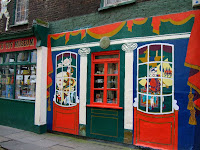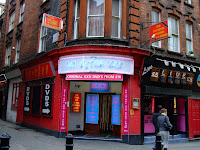
 473 years ago Henry VIII stood on a knoll in Richmond Park waiting to spot a rocket fired from the Tower of London to tell him that Anne Boleyn had been executed. Today the spot is known as King Henry VIII's Mound and although you can't see the Tower of London and no one was firing rockets for us to pin-point it,
473 years ago Henry VIII stood on a knoll in Richmond Park waiting to spot a rocket fired from the Tower of London to tell him that Anne Boleyn had been executed. Today the spot is known as King Henry VIII's Mound and although you can't see the Tower of London and no one was firing rockets for us to pin-point it,  amazingly there is a beautiful framed view of St Paul's Cathedral, 10 miles away to the east. The mound also affords a panoramic view from the northwest to southwest with Ham House and the Thames in the near foreground.
amazingly there is a beautiful framed view of St Paul's Cathedral, 10 miles away to the east. The mound also affords a panoramic view from the northwest to southwest with Ham House and the Thames in the near foreground.We came across this amazing view on a walk from Richmond station, across the Green and past the site of the Tudor Richmond Palace,
 a favoured home of Edward III, Henry VII, and Elizabeth I who all died there.
a favoured home of Edward III, Henry VII, and Elizabeth I who all died there.From Richmond we followed the Thames for a short distance before climbing to Richmond Park then down through Petersham and out to Ham House on the riverbank. Ham House was gifted to the Earl of Dysart by Charles I, possibly as a thankyou to the lad that had grown up with him and been his whipping boy.
 Because it was forbidden to strike the royal personage another lad was given an education and a privileged upbringing in return for taking the royal prince's punishments.
Because it was forbidden to strike the royal personage another lad was given an education and a privileged upbringing in return for taking the royal prince's punishments.After a tour through a few of the rooms that were open for winter viewing we followed the river back to Richmond to catch a train home.









































